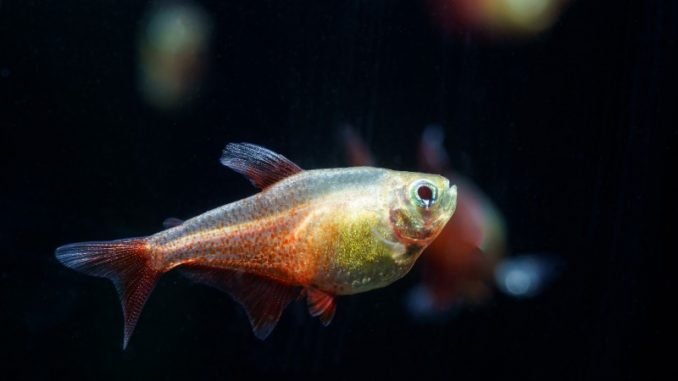
The green fire tetra is a freshwater fish of the tetra family and is native to South America. The green fire tetra has a slender translucent green body with a bright red or orange marking near the anal fin and a black patch on the dorsal fin.
A popular species among aquarists, green fire tetras are shoaling tetras that add character to a tank. Green fire tetras are suitable for beginner aquarists because the fish are easy to care for, although they’re not suitable for some kinds of fish in a community tank.
TABLE OF CONTENTS
Green Fire Tetra Facts & Overview

| Scientific name | Aphyocharax rathbuni |
| Common names | Green fire tetra, Rathbun's bloodfin tetra, redflank bloodfin |
| Distribution | Uruguay, Brazil, Argentina, and Paraguay |
| Size | 1–2 inches |
| Life expectancy | 3–6 years |
| Color | Translucent green, orange/red, and silver |
| Diet | Carnivore |
| Temperament | Peaceful, shoaling, fin-nipper |
| Minimum tank size | 15–20 gallons (for a group of 15 fish) |
| Temperature | 72–80°F (22–27°C) |
| pH | 6.5–7 pH |
| Hardness | 4–8 dGH |
| Care level | Moderate |
| Breeding | Group-spawning egg scatterers |
Origin
Green fire tetras are found in the Paraguay river basin and the river drainages in Argentina, Brazil, Uruguay, and Paraguay. Green fire tetras prefer a natural habitat of slow-moving rivers, tributaries, and streams shaded by overhanging and floating vegetation.
The water conditions in the green fire tetra’s natural habitat change depending on the season, so green fire tetras are hardy and adaptable to minor changes in their habitat.
In the wild, green fire tetras live in groups of six or more, and in aquariums, they should be kept in groups.
Many green fire tetras for sale are captive-bred, but the fish are still commonly found in the freshwater systems in South America.
Adult Size & Lifespan
Captive-bred green fire tetras are sold when the fish are about 1 inch long, and grow up to 1.5 inches in captivity. In the wild, green fire tetras are medium-sized fish and can grow up to 2 inches.
Green fire tetras don’t vary in length based on gender. However, male green fire tetras have a more pointed and slender shape than females, while females have wider and rounder stomachs than males, especially during the breeding season.
Wild green fire tetras live up to six years. Captive green fire tetras usually live up to four years due to the smaller swimming space and variations in their diet.
Availability
Green fire tetras are easy to find in most pet stores that keep tropical fish and online fish stores such as Aquatic Arts, Live Aquaria, and Imperial Tropicals.
Due to the wide availability of green fire tetras, the price per fish is $5–$8. Green fire tetras are often sold in groups because the fish are a shoaling species.
Appearance & Behavior
Green fire tetras are small, slender fish with vibrant green coloring. Green fire tetras are a peaceful species that may nip the long flowy fins of other fish.
Colors, Patterns, Fins, and Sex Differences
The body shape of green fire tetras is slim and slender. Green fire tetras vary in size from other tetras and are not the smallest or largest of tetra fish. Green fire tetras grow up to 2 inches when fully mature.
The green fire tetra stands out from other tetra fish because of its unique coloring. The body of a green fire tetra is metallic green, silver, and yellow around the top half, while the bottom half of the fish is bright red or orange, spanning from the lower belly area to the anal fin.
The green fire tetra has small translucent fins when the fish is young, which turn red and white as the fish matures.
A male green fire tetra fish has white spots on its fins and a shinier coloring than the female. A female green fire tetra fish takes on a more rounded shape when she is ready for spawning.
If the coloring begins to fade on a green fire tetra, the tank lighting may be too bright and should be reduced. The green fire tetra is most vibrant in shaded areas because of the fish’s naturally shaded habitat.
A green fire tetra may also lose its coloring if the fish becomes stressed. Because the green fire tetra is a schooling fish, it should be kept with at least five other green fire tetra fish to prevent stress. The tank’s water conditions should remain clean and within the correct parameters to prevent stress.
Typical Behavior
Green fire tetras are playful and peaceful fish that are confident in large groups. Keep green fire tetras in a group of at least five but preferably to ensure the fish are happy and healthy.
The fish don’t show aggressive behavior, but green tetras have fin-nipping tendencies.
Green fire tetras are slow swimmers that swim around the middle of the tank and among dense live plants. A well-adjusted group of green fire tetras is active and playful throughout the day.
Green Fire Tetra Care & Tank Requirements

Green fire tetras are suitable for beginner aquarists and require a moderate level of care. Keep the tank’s water within the correct parameters to prevent stress and disease.
In captivity, green fire tetras should be housed in a spacious tank with plenty of live plants and shaded areas.
Green fire tetras are carnivores and can be fed high-quality fish pellets. The fish will thrive when fed live or frozen foods including brine shrimp, bloodworms, and tubifex worms.
Habitat and Tank Requirements
Green fire tetras are found in clear, slow-moving freshwater basins that are densely covered with floating vegetation and overhanging plants. The fish’s natural environment offers plenty of shaded areas and shelter.
Green fire tetras appreciate moderate water flow within a tank setup. Densely planted aquariums provide enough shelter for green fire tetras to rest.
Tank setups can include floating plants and low lighting to mimic the natural environment of green fire tetras.
Because green fire tetras don’t burrow or feed in the substrate, substrate choice isn’t of high importance. A dark aquatic soil or sandy substrate will provide enough nutrients for live plants.
Tank Conditions
| Water type: | Soft, freshwater |
| Tank size: | 15–20 gallons (for a group of 15 fish) |
| Water temperature: | 72–80°F (22–27°C) |
| Substrate: | Dark aquatic soil or sandy substrate |
| Tank setup: | Live plants, driftwood, floating vegetation |
| Acidity: | 6.5–7.0 pH |
| Water hardness: | 4–8 dGH |
| Filter: | Yes, a bio-wheel filter is recommended to keep the tank ammonia-free and to create moderate water flow |
| Bubbler: | No, a bubbler is not necessary for a green fire tetra tank |
Green fire tetras require certain water conditions to stay healthy, but the fish can adjust to minor water changes.
Keep tank water parameters stable. Tank water should be filtered to create a moderate water flow and to keep the tank water clean.
Color changes in green fire tetras usually signify stress due to unstable water conditions or predators. Another cause of color changes is disease.
Disease
Green fire tetras are sensitive to toxins and pathogens found in dirty water. All types of tetra fish are prone to a sporozoan disease known as “neon tetra disease”, which has no cure.
To prevent fin rot, ich, and bacterial diseases in green fire tetras, use a high-quality water filter to ensure the tank water is kept clean.
Treat sick green fire tetras quickly and isolate the fish from the rest of the tank to prevent the disease from spreading.
Tank Mates
Green fire tetras are peaceful and get along well with other small and peaceful fish. Green fire tetras should be kept in groups of 15.
Don’t keep long-finned fish with green fire tetras because tetras tend to nip long, flowy fins.
Great tank mates for a green fire tetra include:
- Rasboras
- Discus fish
- Kuhli loaches
- Hillstream loaches
- Danios
- Tetra fish
- Corydoras
- Platies
- Dwarf cichlids
- Swordtails
- Guppies
Diet and Feeding
Wild green fire tetras are carnivores and feed on small invertebrates, crustaceans, and larvae. Feed green fire tetras a healthy diet of high-quality fish flakes or pellets, and live or frozen animal protein including brine shrimp, bloodworms, small fish eggs, and daphnia.
Green fire tetras should be fed once or twice a day with the type of animal protein rotated each day. Make sure all food is small enough to fit in the fish’s mouth and can be eaten within 2 minutes.
Breeding

Green fire tetras are easy to breed. You’ll need a separate freshwater breeding tank filled with live plants and floating vegetation, including Java moss for the egg deposit site. The temperature of the breeding tank should be increased by 2–4°F to encourage breeding.
Follow these steps to breed green fire tetras:
- Place three egg-carrying females with two males into the prepared breeding tank. Females that are ready to breed will have bulging bellies.
- Decrease the light in the breeding tank because green fire tetras prefer to breed in dark areas.
- The male green fire tetra will chase the female fish around until the female lays eggs on a flat surface. Once the eggs are laid, the male green fire tetra will fertilize the eggs.
- Remove the green fire tetras from the breeding tank.
- The fry will hatch within the next five days.
Green fire tetra fry hatch with food in their bellies and don’t need to be fed until they begin swimming around freely, which should happen in five to six days. Feed the fry a high-protein diet of infusoria at first and then baby brine shrimp when their mouths are big enough.
Should You Get a Green Fire Tetra for Your Aquarium?
Green fire tetras are a great addition to a peaceful community tank or a new tank setup as long as you have enough room for at least five. A group of green fire tetras will bring color and excitement to an aquarium.
With that said, green fire tetras shouldn’t be added to community tanks containing long-finned fish because the tetras nip at the other fish’s long fins.
As an easy-to-care-for fish, green fire tetras bring a dazzling luminous color to tanks and have a peaceful but curious nature.

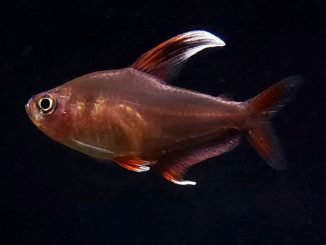
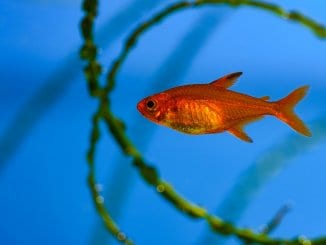
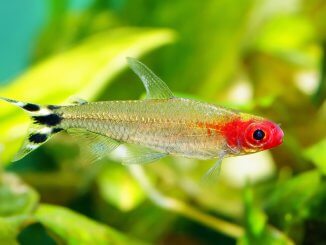
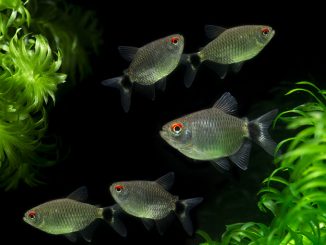
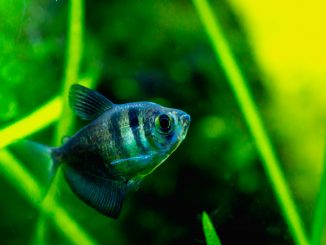
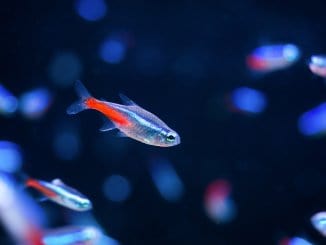
Be the first to comment